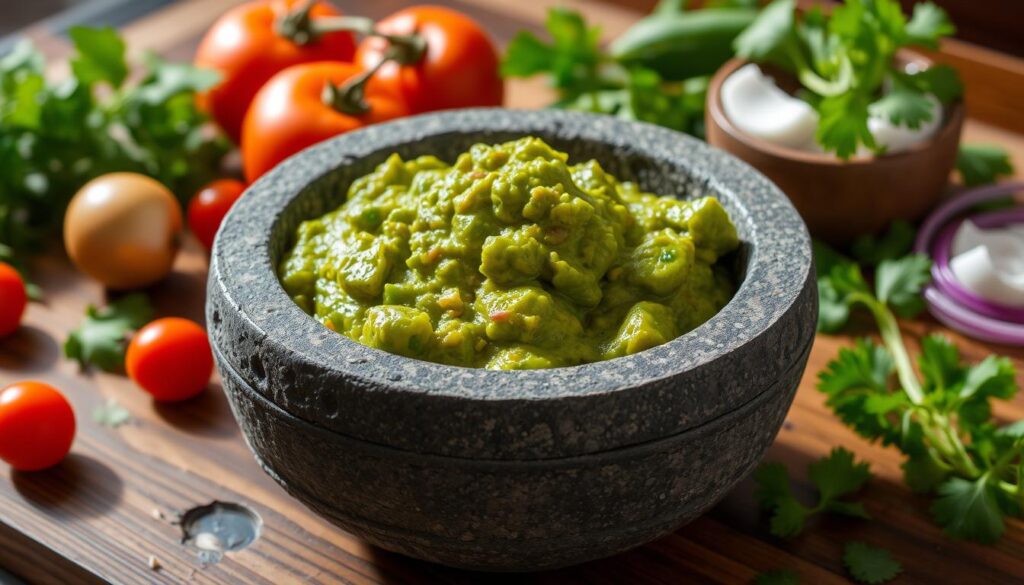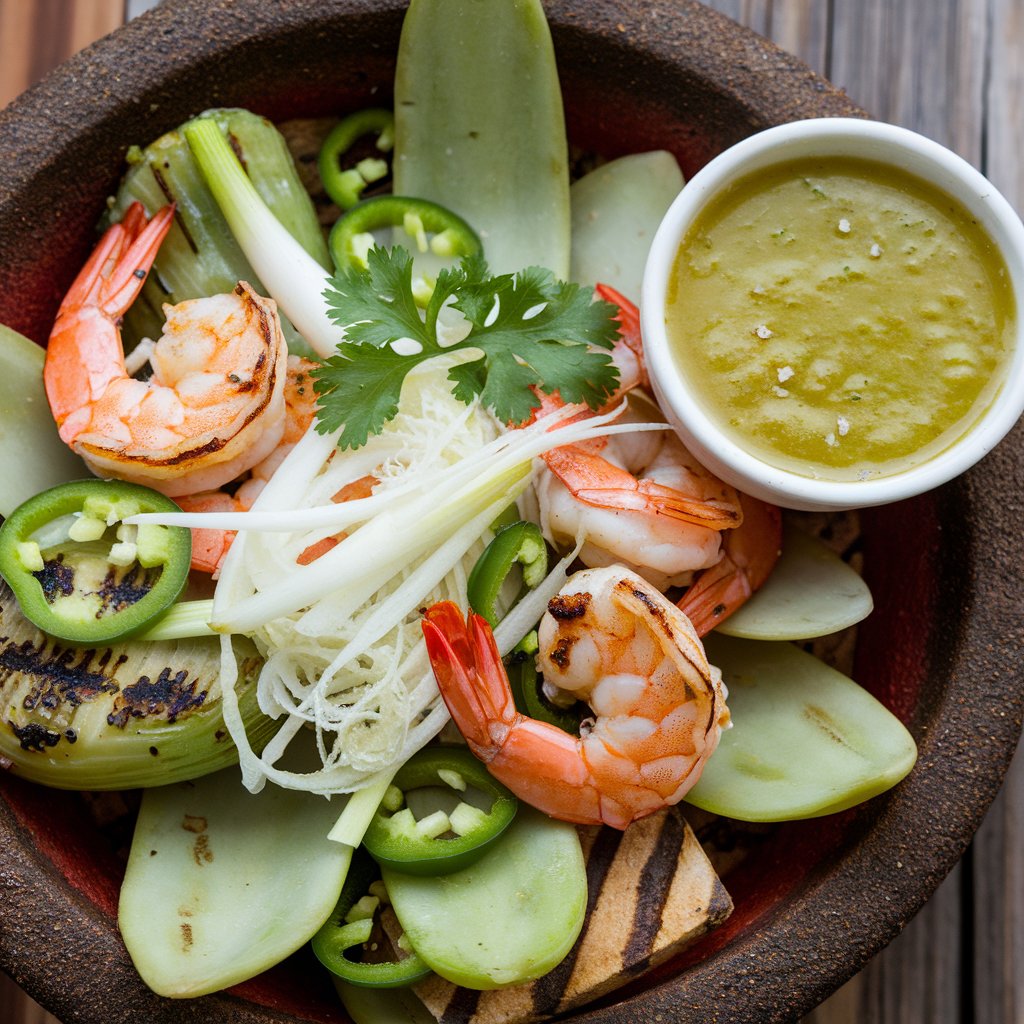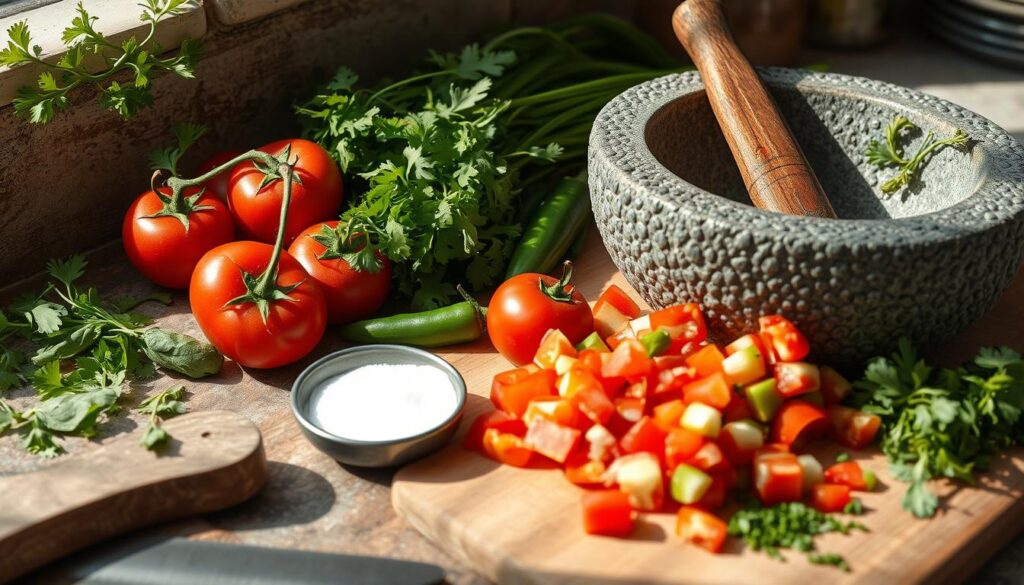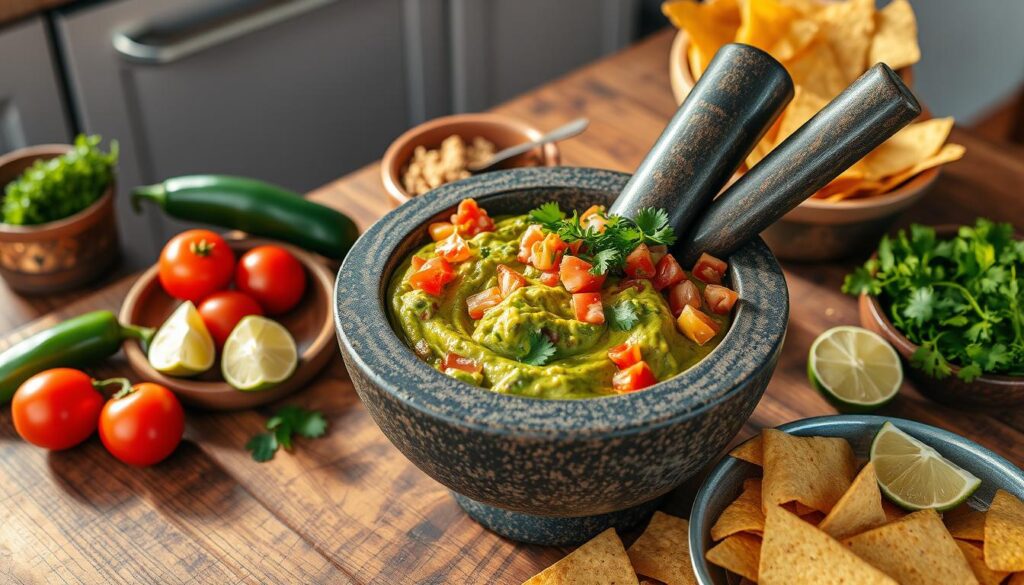Imagine the smell of roasted spices and the sound of sizzling meat. The colors of fresh veggies add to the magic. This is what the molcajete, a Mexican cooking tool, brings to the table. It has been shaping flavors for centuries.
As you start this cooking adventure, let the molcajete’s history and cultural value excite you. It will make your taste buds come alive.
We’ll show you how to make a delicious molcajete dish. You’ll learn the secrets to its rich flavors. This molcajete recipe will take you on a journey through Mexican food, one tasty bite at a time.
What is a Molcajete?
The molcajete is a key part of Mexican cooking. It’s a stone mortar and pestle made from volcanic rock. It helps bring out the rich flavors and textures of Mexican dishes.
Origin and Tradition
The molcajete comes from the Aztec civilization. It was used to grind and mix ingredients like spices, herbs, chiles, and salsas. It’s a tool that has been passed down through generations, showing the lasting impact of Mexican culinary traditions.
Culinary Significance
The molcajete is more than a tool; it’s a symbol of Mexico’s rich food history. Grinding ingredients by hand in the molcajete adds authenticity and connects dishes to Mexico’s roots.
The Uses of Molcajete
- Grinding spices and herbs to release their essential oils and aromas
- Mashing and combining ingredients for salsas, guacamole, and other dips
- Pounding and mixing marinades for meats, poultry, and seafood
- Crushing and blending ingredients for mole sauces and complex flavor profiles
The molcajete’s texture and surface give a unique grinding action. This action can’t be matched by modern appliances. It adds a depth of flavor that makes Mexican cuisine special. Whether making a classic dish or trying something new, the molcajete is essential for authentic Mexican flavors.

Key Ingredients for Your Molcajete Recipe
Making a real molcajete dish starts with picking the right ingredients. You need fresh herbs, spices, meats, seafood, and vegetables. Each one is important for a delicious Mexican meal. Let’s look at the key ingredients to make your molcajete recipe amazing.
Fresh Herbs and Spices
The base of a tasty molcajete is fresh herbs and spices. You’ll need cilantro, cumin, and chili peppers for the real Mexican taste. Try different spices like oregano, garlic, and paprika to mix flavors well.
Meats and Seafood Choices
You have many protein options for your molcajete. Beef, chicken, or pork are great choices. Seafood like shrimp, fish, or octopus adds a fresh taste.
Vegetables That Compliment the Dish
Adding fresh vegetables balances the flavors and texture. Onions, tomatoes, and peppers are good choices. Use seasonal produce to keep your dish interesting.
| Ingredient | Contribution to Molcajete |
|---|---|
| Cilantro | Provides a fresh, herbal flavor |
| Cumin | Adds an earthy, warm spice note |
| Chili Peppers | Infuse the dish with heat and vibrant color |
| Beef | Lends a hearty, satisfying protein element |
| Shrimp | Brings a delicate, ocean-fresh taste |
| Onions | Add aromatic depth and textural contrast |
Choosing the right molcajete salsa ingredients, fresh herbs, spices, meats, seafood, and vegetables makes a memorable dish. It will take you on a flavorful journey to Mexico.

Essential Cooking Tools
Preparing a flavorful Mexican dish with a molcajete requires the right tools. The molcajete, a traditional stone mortar and pestle, is key. But, you’ll also need other tools to make a great meal.
The Traditional Molcajete
The molcajete is essential for any serious Mexican cook. Made from volcanic stone, it’s been used for centuries. It grinds and blends ingredients into fragrant sauces and seasonings.
When choosing a molcajete, look for a rough interior. This texture helps grind ingredients well. The size of the molcajete should match the number of servings you plan to make.
Other Necessary Kitchenware
- Sharp knives for chopping and dicing ingredients
- Cutting boards to prepare your mise en place
- A heavy-duty mortar and pestle (for grinding spices)
- Skillet or sauté pan for cooking the finished dish
- Wooden spoons for stirring and mixing
- Measuring cups and spoons for precise ingredient proportions
With the traditional molcajete and these tools, you’re ready to make a delicious Mexican meal. You’ll use the molcajete, traditional cooking tools, and other kitchen equipment.

Preparing Your Ingredients
Making a delicious molcajete dish starts with careful ingredient prep. You need to wash and chop fresh veggies and marinate meats and seafood. The details matter a lot for the taste.
Washing and Chopping
First, wash all your produce well to remove dirt. Then, chop veggies, herbs, and spices into even pieces. This helps them cook evenly and release their flavors. Proper ingredient preparation is key to unlocking the bold and authentic tastes of your molcajete.
Marinating Meats and Seafood
Marinating proteins is crucial for adding depth to your dish. Mix citrus juices, herbs, and spices for the marinade. Let the meats and seafood soak in the flavors for at least 30 minutes. Marinating not only tenderizes the proteins but also infuses them with irresistible Mexican flavors.
It’s important to keep food safety in mind while preparing ingredients. Make sure all surfaces and tools are clean. Follow safe handling practices for raw meats and seafood to avoid contamination.
| Ingredient | Preparation Tips |
|---|---|
| Tomatoes | Wash, core, and chop into bite-sized pieces |
| Onion | Peel, halve, and thinly slice |
| Garlic | Peel and mince or grate |
| Chicken Thighs | Rinse, pat dry, and marinate in citrus-herb mixture |
| Shrimp | Peel, devein, and marinate in lime juice and spices |
By carefully preparing your ingredients and using the right ingredient preparation and marinating techniques, you’re on your way to a delicious molcajete dish.

Step-by-Step Guide to Making Molcajete
Making a molcajete recipe is like an art form. It lets you bring out the rich flavors of Mexican food. Follow these steps to learn how to use your molcajete and make a dish that’s truly special.
1. Toasting the Ingredients
Begin by toasting your dried chilies, spices, and cumin seeds in a dry skillet or molcajete. Heat it over medium heat. This step makes your ingredients smell amazing and taste even better, starting your molcajete recipe off right.
2. Mixing in the Molcajete
After toasting, let the ingredients cool a bit. Then, put them in your molcajete. Use the tejolote to grind and mash them into a coarse paste. This way, you get the most flavor out of your seasonings.
3. Cooking the Ingredients
Now, add your meats, seafood, or veggies to the molcajete. Keep grinding and mixing until everything is well combined. The molcajete’s heat will cook your ingredients, blending their flavors together perfectly.
4. Final Seasoning
Try your molcajete recipe and adjust the seasoning if needed. Add salt, herbs, or spices to get the taste just right. The goal is to let each ingredient stand out while keeping the flavors balanced.
By following these steps and learning how to use your molcajete, you’ll make a delicious Mexican dish the traditional way.

Serving Suggestions
Take your molcajete dish to the next level with the right flavors and presentation. Explore a variety of Mexican side dishes that match the bold tastes of your molcajete. From vibrant food presentation to thoughtful pairings, let’s explore molcajete serving ideas.
Accompaniments and Sides
With molcajete, the options are endless. Serve it with fresh tortillas, Spanish rice, or a crisp salad. The goal is to balance the strong molcajete flavors with sides that make the meal better.
- Warm, homemade tortillas or tostadas for scooping and dipping
- Fluffy Mexican rice, infused with aromatic spices
- A vibrant salad of mixed greens, diced tomatoes, and tangy lime dressing
- Creamy refried beans or hearty black beans
- Refreshing pico de gallo or chunky guacamole
Presentation Tips
Presenting your molcajete dish with flair can make the meal special. Serve it in the traditional molcajete bowl for a rustic touch. Add fresh herbs, queso fresco, or crema for color and flavor.
Arrange sides in a way that looks good, like in small bowls around the molcajete. This makes the dish look great and shows off its colors and textures.
Common Variations of Molcajete
There are many ways to enjoy molcajete, a traditional Mexican dish. Two favorites are the seafood molcajete and the vegetarian molcajete. Each brings its own taste and experience to the table.
Seafood Molcajete
Seafood fans will love the seafood molcajete. It swaps out the usual meats for shrimp, scallops, and fish. These are marinated in lime juice, garlic, and spices before being cooked in the molcajete.
This dish is full of flavor and packed with protein. It’s a celebration of the sea’s bounty.
Vegetarian Molcajete
For those who don’t eat meat, the vegetarian molcajete is a great choice. It uses fresh veggies like bell peppers, onions, and mushrooms. These are mixed with herbs, spices, and sometimes tofu or beans.
This version is filling and tasty. It’s a great way to enjoy a meat-free meal.
Whether you like the seafood or the vegetarian version, molcajete offers something special. It lets you explore the rich flavors of Mexican cuisine.
Tips for Perfecting Your Molcajete Recipe
Making a great molcajete dish is more than just a recipe. To really improve your cooking, try these expert tips. They’ll help you enhance flavors and master your cooking skills.
Flavor Enhancers
To get the best flavors out of your molcajete, choose your ingredients wisely. Start by toasting your spices and herbs in the molcajete. This step releases their oils and makes their aroma stronger, giving your molcajete salsa a richer taste.
Marinating your meats or seafood in citrus juices, herbs, and spices is another great trick. It tenderizes the protein and adds flavor enhancement that goes well with the dish.
Cooking Techniques
Learning to cook with a molcajete is key for the right texture and taste. Take your time grinding and mashing the ingredients. Use a gentle circular motion to get all the flavors out and mix them well. Rushing this step can ruin the authentic molcajete salsa experience.
Also, watch the cooking time and temperature closely. Simmering the mixture gently lets the flavors blend and grow. But, cooking it too long can make it lose its texture and brightness. Try different cooking tips to find what works best for you.
“The secret to a truly exceptional molcajete dish lies in the patience and care you put into every step of the process.”
Storing Leftovers
Keeping your molcajete dish fresh is easy. Just follow some simple steps for storing and reheating. This way, you can enjoy the Mexican flavors again and again.
Best Practices for Storage
Here are some tips for keeping your molcajete leftovers tasty:
- Put the leftovers in an airtight container or bag. Try to remove as much air as you can to stop oxidation.
- Put the leftovers in the fridge within 2 hours of cooking. Eat them within 3-4 days for the best taste.
- If you have leftovers left, freeze them in containers or bags. They can stay good for up to 3 months in the freezer.
- Write the name of the dish and the date on the containers. This helps you keep track of what you have stored.
Reheating Methods
Here are some ways to reheat your molcajete leftovers:
- Stovetop Reheating: Put the molcajete in a skillet or saucepan. Heat it over medium, stirring often, until it’s warm all the way through.
- Oven Reheating: Preheat your oven to 350°F (175°C). Put the molcajete in a dish that can go in the oven, cover it with foil, and bake for 15-20 minutes. It should be warm by then.
- Microwave Reheating: Put the molcajete in a microwave-safe dish. Heat it in 30-second bursts, stirring between each, until it’s warm enough for you.
By using these tips, you can enjoy your molcajete dish again and again. The bold, authentic flavors will come back to life.
Health Benefits of the Ingredients
The molcajete’s delicious flavors come from its fresh, high-quality ingredients. These ingredients not only taste great but also offer many health benefits. They can improve your overall health.
Nutritional Value of Fresh Ingredients
The fresh herbs, spices, meats, and produce in molcajete recipes are full of vitamins, minerals, and antioxidants. Chilies, tomatoes, and onions are rich in vitamins A and C. Cilantro and oregano are full of beneficial phytochemicals. Even lean proteins like chicken or shrimp add muscle-building amino acids.
Benefits of Traditional Cooking
The traditional molcajete cooking method preserves the nutrients of the ingredients. Unlike modern methods, it keeps the ingredients’ full nutritional value. This slow cooking unlocks the natural flavors of the ingredients, making meals wholesome and flavorful.
Using the molcajete in your cooking lets you enjoy traditional methods and the health benefits of fresh ingredients. This makes Mexican dishes like the molcajete truly special.
Exploring Authentic Mexican Flavors
Exploring authentic Mexican cuisine is a journey into a world of flavors. It shows the variety of regional recipes and unique ingredient pairings. From the Yucatán’s bright tastes to Oaxaca’s complex dishes, Mexican food is a true reflection of its culture.
Regional Differences in Preparation
Every region in Mexico cooks its dishes in its own special way. This is because of local ingredients and long-standing traditions. In the north, you’ll find big, meaty dishes that show the ranching culture. The coasts offer fresh seafood and tropical fruits.
Going south, the flavors get even richer. Chili peppers, complex moles, and creative vegetable dishes are common. This makes Mexican food incredibly diverse.
Popular Ingredient Pairings
- Tomatoes, onions, and garlic are the base of many Mexican sauces. They add depth and complexity to dishes.
- The mix of tomatillo, cilantro, and lime is key. It gives a bright, tangy taste to things like salsa verde and braised meats.
- Combining earthy, roasted chili peppers with creamy avocado is a classic. It’s a big part of what makes Mexican food so special.
| Region | Signature Ingredients | Preparation Techniques |
|---|---|---|
| Yucatán | Achiote, citrus, tropical fruits | Cochinita pibil, salsas with habanero |
| Oaxaca | Moles, heirloom corn, complex chili blends | Slow-cooked stews, tamales, tlayudas |
| Baja California | Seafood, Baja-style sauces, craft beer | Fish tacos, ceviche, beer-battered vegetables |
Discovering the different flavors and ingredients in Mexican cuisine is a treat. It’s a journey that delights the senses and celebrates the rich variety of this vibrant food culture.
Conclusion: Enjoying Your Molcajete Experience
The molcajete is more than a cooking tool. It opens a door to a world of flavors in Mexican cuisine. By following this guide, you’ve learned to make a delicious molcajete dish. It combines fresh ingredients with traditional techniques.
Share with Friends and Family
Now, you’re ready to share your molcajete skills with others. Invite your family and friends to enjoy your homemade dish. Sharing meals brings people together and keeps the molcajete’s cultural value alive.
Experimenting with New Flavors
The molcajete is very versatile. After mastering the classic recipe, try new ingredients and flavors. Explore different regional dishes or add your favorite meats, seafood, or veggies. The molcajete experience is about exploring and finding new flavors in Mexican cuisine.

